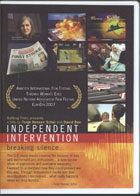
Independent Intervention 2006
Distributed by Bullfrog Films, PO Box 149, Oley, PA 19547; 800-543-FROG (3764)
Produced by Ground Productions
Directed by Tonje Hessen Schei
DVD, color, 75 min.
Sr. High - Adult
Communication, Journalism
Date Entered: 01/22/2008
Reviewed by K. Johan Oberg, University of Minnesota, Wilson Library, Minneapolis, MNSince the invasion into Iraq in April, 2003, at least a dozen documentaries have been made about the Iraq war and media, including the Indymedia War and Peace Trilogy, We Interrupt This Empire, Control Room, Hollywood Victory: Delusions of a Maverick President, PBS’s Reporting America at War, WMD: Weapons of Mass Deception, Militainment, Inc.: Militarism and Pop Culture, and War Spin, the BBC program about the theatrics surrounding the staged rescue of Jessica Lynch.
Independent Intervention aims to provide an alternative picture of the second war in Iraq and asserts that independent media has an important role to play as a counterbalance to mainstream corporate media. Over the course of nine chapters, this documentary tells about the gruesomeness of war that is not reported in mainstream American media. It is narrated by the filmmaker, Tonje Hessen Schei, and features commentaries by Char Jamail, an independent American journalist, Amy Goodman of the independent news organization Democracy Now, Danny Schechter, creator of the documentary WMD: Weapons of Mass Deception and long-time broadcast journalist and producer, and Noam Chomsky, professor of linguistics.
The narration and the commentaries are accompanied by examples of mainstream American television media’s image-intense presentations and by images taken by independent journalists in Iraq. The footage from independent journalists shows Iraqi people bleeding, dying or burning, and children and parents running from gunfire and bombs, as well as interviews with survivors commenting on their experiences. The chapter describing the intimidation of independent journalists by American forces is particularly interesting. This film is quite obviously made by someone who passionately believes the second Iraq war is wrong. The footage of suffering and death is disturbing and it provokes questions about whether this is a senseless war and, ultimately, what responsibility mainstream American media has had in its promotion.
From an academic or a journalistic point of view, the film has a few shortcomings. For example, the voice of those who may disagree is not presented except in a brief clip of Aaron Brown being interviewed on Democracy Now. Considering that the film is critical of the American military’s information control practices and of mainstream media, it could have gained from comments from these entities. Also, the chapter on who owns the media in the United States could have included more details.
Nevertheless, I recommend the film as it quite convincingly conveys that there is another story to the second Iraq war and that independent media has a role to play. Consider combining it with Militainment, Inc. (distributed by the Media Education Foundation), which is an excellent analysis of mainstream media’s coverage of the second Iraq War.